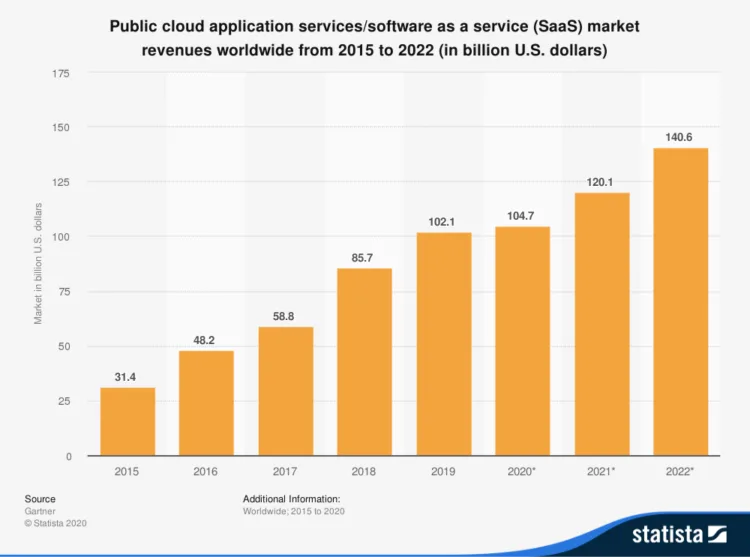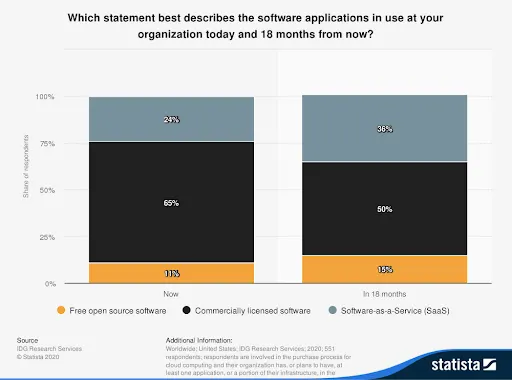The History of SaaS: From Emerging Technology to Ubiquity


The History of SaaS: From Emerging Technology to Ubiquity
Get The Print Version
Tired of scrolling? Download a PDF version for easier offline reading and sharing with coworkers.
A link to download the PDF will arrive in your inbox shortly.
When people think about the first software-as-a-service (SaaS) startup, typically Salesforce comes to mind. But while Salesforce began as a SaaS, other early SaaS software started on the floppy disks and CD-ROMs of the pre-internet time.
Look at business travel and expense software Concur. After the 2001 market crash, Concur moved away from physical software to become a pure SaaS business. It then grew so fast that, in 2014, SAP bought Concur in what was then the largest ever SaaS acquisition.
The last twenty years have seen a lot of SaaS growth, taking the software development model from its infancy into where it is today — powering a significant amount of the business processes at even large enterprises.
What is SaaS?
SaaS platforms make software available to users over the internet, usually for a monthly subscription fee.
With SaaS, you don’t need to install and run software applications on your computer. Everything is available over the internet via your web browser when you log into your account online. You can usually access the software from any device, anytime (as long as there is an internet connection).
The same goes for anyone else using the software. All your staff will have personalized logins, suitable to their access level.
You no longer need to engage an IT specialist to download the software onto multiple computers throughout your office or worry about keeping the software on every computer up-to-date. It’s all taken care of in the cloud.
Another key difference is the business model. For pricing, most SaaS providers operate a tiered subscription model with fixed, inclusive monthly account fees.
Most subscriptions include maintenance, compliance, and security services, which can be time-consuming and costly.
SaaS vendors also offer out-of-the-box solutions that are simple to set up (if you need a basic package), with more complex solutions for larger organizations. You could have the basic software up and running within a matter of hours – and you’ll have access to customer service and support along the way.
SaaS vs PaaS vs IaaS
Software-as-a-service, platform-as-a-service, and infrastructure-as-a-service are three different models for running your business from the cloud.
IaaS: cloud-based services, pay-as-you-go for services such as storage, networking, and virtualization. If your business engages data centers, that falls under IaaS.
PaaS: hardware and software tools available over the internet.
SaaS: software that’s available via a third-party over the internet.
On-premise: software that’s installed in the same building as your business.
The History of SaaS
The emergence of cloud computing enabled software to be installed on off-premise remote servers which, in some cases, were maintained by third parties. This reduced the amount of necessary maintenance and better enabled an increasingly global workforce, because software “in the cloud” was accessible from anywhere.
Over time, improvements to the internet decreased the cost of hosting, leading to platforms lifting many of the early bandwidth limitations, and made online business processes faster and more reliable.
Cost-efficiency, ease of use, and improvements to core functionality all led to exponential growth in SaaS. Today, it’s a practical option even for enterprise-level businesses.
1. SaaS in the beginning.
In the 1960s, computer hardware technology was progressing rapidly. However, computing still took a lot of time — and the cost of a mainframe was prohibitive to many organizations. That’s where time-sharing comes in. That’s where time-sharing comes in. A Compatible Time-Sharing System (CTSS) was developed at MIT and demonstrated effective first in 1961.
2. Pre-SaaS computing.
Over the next 20–30 years, hardware and computing became less expensive and more portable. That’s when businesses shifted toward individual “ownership”: personal computers and on-premise software installed on that machine as part of a purchased license.
But on-premise software proved to be inefficient at scale — for both the IT staff managing it and the software companies selling it.
IT found themselves bogged down in software installations, updates, security patching, and hardware and infrastructure maintenance of personal business computers. Software businesses had lower margins because of cost of goods sold (COGS) — the costs of software distribution on disks within product packaging.
3. Rise of dot com.
In August of 1994, the internet took a big step forward.
Online Transactions
Daniel Kohn conducted the first secure credit card transaction for a physical good — a Sting CD. In an article published in the New York Times the very day after the transaction, the reporter wrote:
“While Commercenet [a government and industry organization] and other organizations have been working to develop a standard for the automated data encryption of commercial transactions, the small band of recent college graduates who formed the Net Market Company in New Hampshire appear to be the first to implement such technology successfully.”
Thereafter, everything that made ecommerce as we know it today started happening really quickly.
Netscape Navigator, in October 1994, introduced the Secure Sockets Layer (SSL) protocol, enabling encrypted transmission of data over the internet so people could shop online without fear of losing their data.
Online Marketplaces
The very next year saw the launch of Jeff Bezos’ Amazon and Pierre Omidyar’s AuctionWeb, which we know today as eBay, the first peer-to-peer auction marketplace.
By the end of 2000, though it began as an ecommerce platform for books, Amazon had already branched out into other product categories and begun allowing third-party sellers to use the platform.
Online Cloud
One of the benefits of the rise of the internet was the emergence of cloud computing. That allowed software to be installed on remote servers which, in some cases, were maintained by third parties.
This helped reduce the amount of necessary maintenance and better enabled an increasingly global workforce, because software “in the cloud” was accessible from anywhere.
Those functionality improvements began a move toward best-of-breed software providers who focused on doing one core function really well — allowing organizations to plug and play the software for each function that worked best for their business.
4. Creation of application service providers.
With an Application Service Provider (ASP), the main idea is essentially the same as that of SaaS — it provides computer-based services over a network. But, whereas SaaS is self-service, with the ASP model the vendor had to manually create each login and environment.
5. SaaS officially is here.
In 1999, Salesforce launched their customer relationship management (CRM) platform as the first SaaS solution built from scratch to achieve record growth. It proved to be a good investment, because the dot-com bust in 2001 — followed less than a decade later by the Great Recession — landed a significant hit to on-premise software.
In its infancy, the SaaS model was thought to be only for startups and small businesses, just a fad, too closed, too slow or unstable. But over the next several years, improvements to the internet that meant little to the traditional software industry, did much for SaaS.
In the earliest days of the SaaS industry, it was assumed that subscription-based software would not be viable for enterprise business. And, in fact, in those days the enterprise typically chose end-to-end software suites to manage their complex organizations.
6. SaaS reaches ubiquity.
Today, exponential growth of SaaS and continued improvements to functionality make it a valid option even for enterprise-level businesses. It’s also much cheaper and easier to use. SaaS customers frequently cite cost savings as one of its primary benefits.
You can find SaaS products for almost any business applications you can think of.
7. Future of SaaS.
The popularity of SaaS is evident in all the software industry giants moving toward using it, including Microsoft, SAP, Oracle and IBM. As SaaS industry adoption continues to grow, here are some of the things we may see happen in the software industry.
New roles of IT and the CIO: As SaaS apps are more often marketed to line-of-business users instead of technology decision-makers, IT must evolve into a proactive business partner that can help make sure purchase decisions are prudent in the context of broader organizational and IT goals.
Greater focus on automation: SaaS is making it easier for businesses to incorporate AI technology into their tech stacks. One example is using chatbots with artificial intelligence for quicker, more efficient customer service.
More open integrations: APIs will continue to grow in importance as SaaS products provide avenues for integration. Greater integration will make it easier even for smaller businesses to use business intelligence to improve their operations.
Openness will lead to flexibility: SaaS has come a long way from its initial form. Now, it’s much more flexible, and added emphasis on APIs will continue to make it more open and customizable for all businesses. That flexibility will lead to the kind of integrated systems the business of the future will need — like seamless connections between your ecommerce platform and other solutions like IMS/OMS, PIM, and ERPs.
SaaS Adoption Is Growing
“Years ago, SaaS limited your flexibility. You couldn’t make it your own. You had to go down a path of a custom platform,” said Chief Product Officer Jimmy Duvall. “That dynamic has shifted.”
The valuation of the market for SaaS products continues to grow. Despite a pause in growth between 2019 and 2020, likely due to a predicted holding pattern while the world reckons with the unprecedented impact of the pandemic, Gartner predicts the growth returns in 2021.

You can also see that organizations plan to reduce the use of commercially licensed software over the next 18 months, increasing free open source slightly, with a more significant increase in SaaS products.

As much as 67% of enterprise infrastructure will be cloud-based by the end of 2020.
Revolutionizing Businesses With SaaS (Advantages)
The SaaS market originally emerged to enable small businesses or individuals who couldn’t afford large enterprise software suites. Compared to on-premise software, though, end users were very limited in what they could do with SaaS — particularly because in early days bandwidth and file sizes were capped. Most mainstream players found SaaS to be too closed, slow or unstable to support any meaningful business activities.
Over time, improvements to the internet including more reliable broadband decreased costs, leading to platforms lifting many of the early bandwidth limitations and making scalability more possible, and made online business processes faster and more reliable.
Cost-efficiency, ease of use, and improvements to core functionality all led to exponential growth in SaaS. Today, it’s a practical option even for enterprise-level businesses.
1. Platform independent.
Since SaaS solutions are typically accessed on the web, they can be run on any operating system or device. That means it can be used by anyone, regardless of Windows versus Mac, iPhone versus Android, or even a Linux system.
2. Quick updates.
With SaaS, your software will be updated automatically when new features are released. No more having to wait for your IT team to have time after an update is issued. Keeping up with the security patches AND version updates necessary to have the latest secure version of an open source solution is time-consuming and labor intensive.
3. Relatively low cost.
SaaS also reduces users’ total cost of ownership when compared to open source. Because all of your hosting and maintenance is included, using a SaaS solution can not only give you a lower total cost of ownership, but it can also make it easier to calculate your operating costs with fewer surprises. Most SaaS platforms include all the bandwidth your store might need.
4. Secure data.
According to a study by KPMG, about 30 percent of customers would stop purchasing from a company temporarily after a data breach. Security is one less thing on your plate if you choose a SaaS option. Most SaaS ecommerce providers are PCI compliant and some include even stricter data security. For example, BigCommerce is ISO/IEC 27001:2013 certified, which is an internationally-recognized standard for information security.
5. Easy to use.
You no longer have to worry about software installation, updates, maintenance, or configuring your servers. All of this is handled for you by the platform provider, making SaaS options easier to set up and and to use. SaaS platforms also provide customer support to help with any challenges you do run into. This is support that goes beyond just phone calls for a major issue. You can call and get guidance on setting up a new feature or if you get stuck figuring out an integration.
Ecommerce SaaS Companies
SaaS ecommerce platforms provided an alternative to open source with less complexity and reduced barrier to entry.
1. BigCommerce.
BigCommerce is one of the leading open SaaS ecommerce platforms for mid-market and enterprise brands.
2. Shopify.
Shopify, like BigCommerce, is feature-rich, easy to use, and helps businesses get up and running quickly. Businesses that are totally new to ecommerce may choose to start with Shopify stores. The disadvantage of Shopify is that it can be difficult to scale. Shopify Plus requires a 3rd party app to achieve the 600 product variants that can be done on BigCommerce natively.
3. Salesforce Commerce Cloud.
Salesforce Cloud Commerce, formerly Demandware, is a SaaS ecommerce platform provider preferred often by high-profile fashion retailers. The disadvantages of Salesforce Cloud Commerce are the high cost and the dependence on developers. The platform has a higher annual cost with a 3-5 year contract, and an implementation can easily cost upwards of $250K. Merchants face additional obstacles and costs if they choose a third-party over Salesforce’s add-on services.
4. Shift4Shop.
Shift4Shop is another SaaS ecommerce platform, though typically considered more of a minor player. Its advantages include multilingual support and advanced shipping solutions – no API required. Disadvantages include a lack of a CDN, resulting in poor site uptime during high traffic volumes for stores and difficult to reach customer service. They also lack modern responsive themes.
Wrapping Up
SaaS has come a long way since its first simple applications 20 years ago. Today, its increasing flexibility and openness lends itself to businesses building best-of-breed tech stacks instead of dropping into a software suite of already connected solutions.
This is giving businesses more freedom to run their back offices the way they want to — and the way that’s most effective for them.
When it comes to ecommerce, more and more merchants are realizing the benefits that come from a SaaS platform versus open source: lower total cost of ownership, regular software updates, ease of use, and platform security.

Victoria is a content marketing writer, researcher, and content project manager at BigCommerce. Specializing in writing and web content strategy, she previously spent eight years in public relations and marketing for Tier I research universities. She holds a B.A. in English Writing and Rhetoric from St. Edward’s University and a Master of Liberal Arts from Lock Haven University of Pennsylvania.


